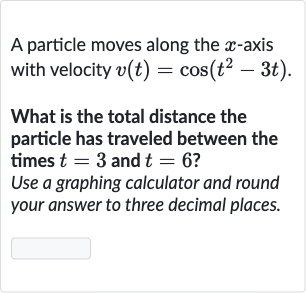Full solution
Q. A particle moves along the -axis with velocity .What is the total distance the particle has traveled between the times and ?Use a graphing calculator and round your answer to three decimal places.
- Set up integral: Set up the integral to find the total distance. Distance =
- Plug in velocity function: Plug in the velocity function into the integral.Distance =
- Evaluate integral with calculator: Use a graphing calculator to evaluate the integral. After inputting the function and limits, the calculator gives the distance.
- Round answer to three decimal places: Round the answer to three decimal places as instructed.Let's say the calculator shows the distance to be .Rounded distance =
More problems from Relate position, velocity, speed, and acceleration using derivatives
QuestionGet tutor help
QuestionGet tutor help
QuestionGet tutor help
QuestionGet tutor help
QuestionGet tutor help
QuestionGet tutor help
QuestionGet tutor help
QuestionGet tutor help
QuestionGet tutor help
QuestionGet tutor help



